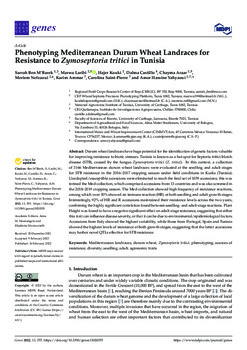Mostrar el registro sencillo del ítem
Phenotyping mediterranean durum wheat landraces for resistance to zymoseptoria tritici in Tunisia
| Creador: | Ben M’Barek, S. |
| Creador: | Laribi, M. |
| Creador: | Kouki, H. |
| Creador: | Castillo, D. |
| Creador: | Araar, C. |
| Creador: | Nefzaoui, M. |
| Creador: | Ammar, K. |
| Creador: | Saint Pierre, C. |
| Creador: | Yahyaoui, A.H. |
| Año: | 2022 |
| URI: | https://hdl.handle.net/10883/22011 |
| Lenguaje: | English |
| Editor: | MDPI |
| Copyright: | CIMMYT manages Intellectual Assets as International Public Goods. The user is free to download, print, store and share this work. In case you want to translate or create any other derivative work and share or distribute such translation/derivative work, please contact CIMMYT-Knowledge-Center@cgiar.org indicating the work you want to use and the kind of use you intend; CIMMYT will contact you with the suitable license for that purpose |
| Tipo: | Article |
| País de enfoque: | Tunisia |
| Lugar de publicación: | Basel (Switzerland) |
| Número: | 2 |
| Volumen: | 13 |
| DOI: | 10.3390/genes13020355 |
| Palabras Claves: | Durum Wheat |
| Palabras Claves: | Zymoseptoria tritici |
| Palabras Claves: | Phenotyping |
| Palabras Claves: | Sources of Resistance |
| Palabras Claves: | Diversity |
| Palabras Claves: | Agronomic Traits |
| Descripción: | Durum wheat landraces have huge potential for the identification of genetic factors valuable for improving resistance to biotic stresses. Tunisia is known as a hot spot for Septoria tritici blotch disease (STB), caused by the fungus Zymoseptoria tritici (Z. tritici). In this context, a collection of 3166 Mediterranean durum wheat landraces were evaluated at the seedling and adult stages for STB resistance in the 2016–2017 cropping season under field conditions in Kodia (Tunisia). Unadapted/susceptible accessions were eliminated to reach the final set of 1059 accessions; this was termed the Med-collection, which comprised accessions from 13 countries and was also screened in the 2018–2019 cropping season. The Med-collection showed high frequency of resistance reactions, among which over 50% showed an immune reaction (HR) at both seedling and adult growth stages. Interestingly, 92% of HR and R accessions maintained their resistance levels across the two years, confirming the highly significant correlation found between seedling-and adult-stage reactions. Plant Height was found to have a negative significant effect on adult-stage resistance, suggesting that either this trait can influence disease severity, or that it can be due to environmental/epidemiological factors. Accessions from Italy showed the highest variability, while those from Portugal, Spain and Tunisia showed the highest levels of resistance at both growth stages, suggesting that the latter accessions may harbor novel QTLs effective for STB resistance. |
| Agrovoc: | AGRONOMIC CHARACTERS |
| Agrovoc: | HARD WHEAT |
| Agrovoc: | SEEDLINGS |
| Agrovoc: | LANDRACES |
| Datasets relacionados: | https://www.mdpi.com/2073-4425/13/2/355#supplementary |
| ISSN: | 2073-4425 |
| Revista: | Genes |
| Número de artículo: | 355 |
| Área de impacto CGIAR: | Nutrition, health & food security |
| Iniciativa CGIAR: | Accelerated Breeding |
| Área de acción CGIAR: | Genetic Innovation |
| Donante o financiador: | CGIAR Research Program on Wheat |
| Donante o financiador: | Precision Phenotyping Septoria Platform (Tunisia) |
| Donante o financiador: | United States Agency for International Development (USAID) |
| Donante o financiador: | Bureau for Resilience and Food Security as part of Feed the Future (RFS) |
| Identificador CGSpace: | https://hdl.handle.net/10568/126540 |
Ficheros en el ítem
Este ítem aparece en la(s) siguiente(s) colección(ones)
-
Wheat
Wheat - breeding, phytopathology, physiology, quality, biotech

